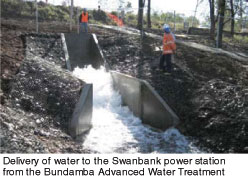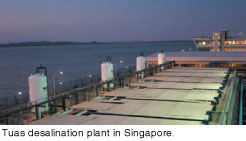|
by Lay Leng TAN
 ith climate change affecting global water sources, how do water utilities cope? Singapore-based James Currie, regional operations manager and associate vice president with Black & Veatch (B&V) Water, notes that water utilities increasingly look to diversity for security of their water supplies. Many, which have been long dependent on surface water sources involving reservoirs and treatment plants for water, now realise that traditional sources may not remain available or sustainable and that they need to seek alternatives. ith climate change affecting global water sources, how do water utilities cope? Singapore-based James Currie, regional operations manager and associate vice president with Black & Veatch (B&V) Water, notes that water utilities increasingly look to diversity for security of their water supplies. Many, which have been long dependent on surface water sources involving reservoirs and treatment plants for water, now realise that traditional sources may not remain available or sustainable and that they need to seek alternatives.
Drought has been plaguing Australia over the last few years, and the continent recognises that it now faces climate change. This mindset shift requires a different approach to dealing with the problem because the continent now accepts that it may not be able to rely on rainwater any longer.
Singapore provides a textbook study of diversification strategies. It treats secondary effluent to produce NEWater and taps seawater via desalination. Some drought-hit states in Australia are adopting this model of securing water supplies through diversity.
 Other means of generating and storing water depend on climate, and use of groundwater can pose challenges in terms of sustainability of supply and possible contamination of shallow aquifers. Some places, like Western Australia, are considering the adoption of aquifer recharge whereby reclaimed wastewater would be channelled into the ground and stored at depth until needed. Other means of generating and storing water depend on climate, and use of groundwater can pose challenges in terms of sustainability of supply and possible contamination of shallow aquifers. Some places, like Western Australia, are considering the adoption of aquifer recharge whereby reclaimed wastewater would be channelled into the ground and stored at depth until needed.
A growing number of utility companies link water resources, such as surface water or reservoirs, into water networks and grids for more efficient storage and usage. For example, the A$2.4 billion Western Corridor Recycled Water Project in South East Queensland currently under construction includes building pipelines to collect secondary effluent from six wastewater treatment plants and conveying it to three advanced water reclamation plants that will supply recycled water to two major power stations and a reservoir — thus relieving the pressure on traditional water sources.
In addition, the Queensland state government is investing in the South East Queensland Water Grid which will provide a network of two-way pipelines to connect major bulk water sources in the region. This network will transfer water from areas of water surplus to areas that are in deficit, while at the same time allowing risks to be managed at the regional level rather than on a storage basis. The water grid will also allow better coordination of major water supply sources in South East Queensland.
Currie observes that the classic distinction between water treatment and wastewater treatment is fast disappearing as pristine sources of water supply diminish. Many traditional water treatment processes are becoming more prevalent in treating wastewater so that the same utility company now treats both to supply water for different uses. However, many countries are still grappling with how best to combine or optimise these two sectors because of political, social, and institutional complexities.
Integrating water and energy as a single solution by optimising the design for both can also result in great advantages. Such integration has been increasingly expanded, resulting in a single company to produce power, water, and other utilities like steam or chilled water. Currie sees this happening on Singapore's Jurong Island, the petrochemical industry hub.
The application of membranes for water treatment is growing rapidly. A polymeric membrane typically lasts about seven years before it needs to be replaced. A higher-cost but more durable ceramic membrane currently under development may present a more cost-effective solution in the long run.
 Currie notes that a ceramic membrane has a lifespan significantly longer than for polymeric membranes thanks to its structure which is significantly more robust and less prone to chemical attack. Ceramic membranes that have been fouled can more easily be cleaned and restored to original performance levels due to their ability to endure higher backwash pressures and more concentrated cleaning solutions. In comparison, traditional polymeric membranes have to be replaced earlier and are more prone to wear and tear. The future of ceramic membranes now lies in understanding how well the technology works in practice when transferred from the laboratory to full-scale application. Currie notes that a ceramic membrane has a lifespan significantly longer than for polymeric membranes thanks to its structure which is significantly more robust and less prone to chemical attack. Ceramic membranes that have been fouled can more easily be cleaned and restored to original performance levels due to their ability to endure higher backwash pressures and more concentrated cleaning solutions. In comparison, traditional polymeric membranes have to be replaced earlier and are more prone to wear and tear. The future of ceramic membranes now lies in understanding how well the technology works in practice when transferred from the laboratory to full-scale application.
B&V is collaborating with Singapore's national water agency Public Utilities Board (PUB) and Japan's NGK Water Environment System, Ltd on a one-year pilot programme at the Bedok NEWater Factory to explore the application of ceramic membranes to pretreat wastewater for a reuse application. The expectation is that these membranes will ultimately be used as pretreatment in seawater desalination or wastewater treatment processes.
If the ocean can provide an endless supply of water, why do water-stressed countries not jump into seawater desalination? Desalination has until recently involved energy-intensive processes, the viability of which has been adversely affected by fuel prices. Previously only oil-rich Middle Eastern nations have chosen this approach as they have had the black gold to power the operation.
However, with the advent of advanced materials and more efficient designs, desalination technology is becoming an increasingly viable solution despite the current oil crunch. Currie explains that the term desalination can be applied equally to seawater desalting as to reverse osmosis (RO) treatment of other water sources such as brackish water, saline ground water, and wastewater. When comparing the entire life costs of different water treatments, desalination can be as competitive as conventional treatment processes depending on the water to be treated and the required quality of the product water. Research into energy efficiency of desalination plants is also seeing improved designs and techniques in the treatment process, resulting in reduced energy requirements for desalination of seawater.
The Singapore Tuas Seawater Desalination Plant was awarded a distinction in the Water Plant of the Year category at the 2006 Global Water Awards as one of the most energy-efficient seawater RO plants in the world. The plant, which was developed and built by SingSpring, used B&V expertise for the design as well as significant aspects of the construction and commissioning of the plant. The plant produces treated water at total plant specific energy consumption of only 4.2kWhr/m3. This was a major factor in the first-year selling price of US$0.49/m3 — the lowest of any comparable project in the world.
The success of a desalination facility depends very much on the pretreatment processes selected. One pretreatment process developed by B&V adopts a combined flotation and filtration process that reduces the footprint, while removing algae and suspended solids in a single treatment stage. Both activities occur within the same reactor — the flotation in the upper part of the tank and the filtration in the lower part. Creative design configuration allows for future modification if the need arises.
B&V's value proposition lies in its global approach, international experience available to local projects, and innovation arising from the breadth of knowledge shared among its integrated workforce in various offices around the world. Global resources applied locally, and local resources applied globally — this strategy has worked to make it one of the key players in the water market.
 Click here to download the full issue for USD 6.50 Click here to download the full issue for USD 6.50
|


 ith climate change affecting global water sources, how do water utilities cope? Singapore-based James Currie, regional operations manager and associate vice president with Black & Veatch (B&V) Water, notes that water utilities increasingly look to diversity for security of their water supplies. Many, which have been long dependent on surface water sources involving reservoirs and treatment plants for water, now realise that traditional sources may not remain available or sustainable and that they need to seek alternatives.
ith climate change affecting global water sources, how do water utilities cope? Singapore-based James Currie, regional operations manager and associate vice president with Black & Veatch (B&V) Water, notes that water utilities increasingly look to diversity for security of their water supplies. Many, which have been long dependent on surface water sources involving reservoirs and treatment plants for water, now realise that traditional sources may not remain available or sustainable and that they need to seek alternatives.
 Other means of generating and storing water depend on climate, and use of groundwater can pose challenges in terms of sustainability of supply and possible contamination of shallow aquifers. Some places, like Western Australia, are considering the adoption of aquifer recharge whereby reclaimed wastewater would be channelled into the ground and stored at depth until needed.
Other means of generating and storing water depend on climate, and use of groundwater can pose challenges in terms of sustainability of supply and possible contamination of shallow aquifers. Some places, like Western Australia, are considering the adoption of aquifer recharge whereby reclaimed wastewater would be channelled into the ground and stored at depth until needed.
 Currie notes that a ceramic membrane has a lifespan significantly longer than for polymeric membranes thanks to its structure which is significantly more robust and less prone to chemical attack. Ceramic membranes that have been fouled can more easily be cleaned and restored to original performance levels due to their ability to endure higher backwash pressures and more concentrated cleaning solutions. In comparison, traditional polymeric membranes have to be replaced earlier and are more prone to wear and tear. The future of ceramic membranes now lies in understanding how well the technology works in practice when transferred from the laboratory to full-scale application.
Currie notes that a ceramic membrane has a lifespan significantly longer than for polymeric membranes thanks to its structure which is significantly more robust and less prone to chemical attack. Ceramic membranes that have been fouled can more easily be cleaned and restored to original performance levels due to their ability to endure higher backwash pressures and more concentrated cleaning solutions. In comparison, traditional polymeric membranes have to be replaced earlier and are more prone to wear and tear. The future of ceramic membranes now lies in understanding how well the technology works in practice when transferred from the laboratory to full-scale application.
 Click here to download the full issue for USD 6.50
Click here to download the full issue for USD 6.50